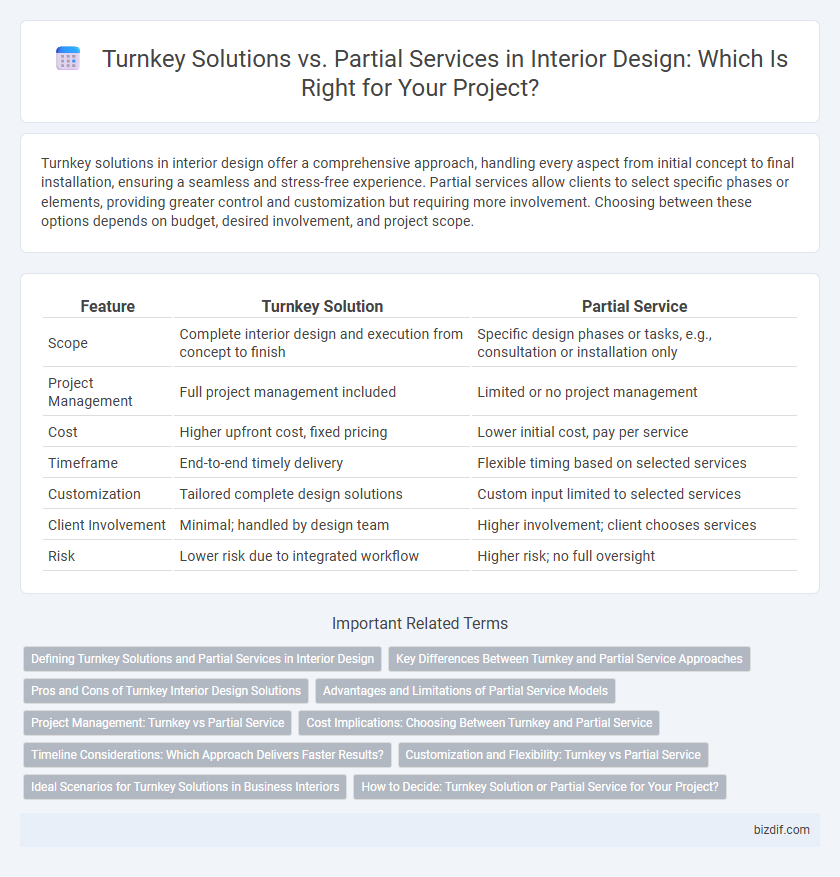Turnkey solutions in interior design offer a comprehensive approach, handling every aspect from initial concept to final installation, ensuring a seamless and stress-free experience. Partial services allow clients to select specific phases or elements, providing greater control and customization but requiring more involvement. Choosing between these options depends on budget, desired involvement, and project scope.
Table of Comparison
| Feature | Turnkey Solution | Partial Service |
|---|---|---|
| Scope | Complete interior design and execution from concept to finish | Specific design phases or tasks, e.g., consultation or installation only |
| Project Management | Full project management included | Limited or no project management |
| Cost | Higher upfront cost, fixed pricing | Lower initial cost, pay per service |
| Timeframe | End-to-end timely delivery | Flexible timing based on selected services |
| Customization | Tailored complete design solutions | Custom input limited to selected services |
| Client Involvement | Minimal; handled by design team | Higher involvement; client chooses services |
| Risk | Lower risk due to integrated workflow | Higher risk; no full oversight |
Defining Turnkey Solutions and Partial Services in Interior Design
Turnkey solutions in interior design encompass comprehensive project management from initial concept through final installation, delivering a fully finished space ready for immediate use. Partial services focus on specific aspects of the interior design process, such as space planning, material selection, or furniture procurement, allowing clients to retain control over other project components. Choosing between turnkey and partial services depends on the client's budget, timeline, and desired level of involvement in the design process.
Key Differences Between Turnkey and Partial Service Approaches
Turnkey solutions in interior design deliver end-to-end project management, covering everything from initial concept and design to procurement, construction, and final installation, ensuring a seamless and comprehensive experience. Partial service approaches provide clients with selective support, focusing on specific phases such as design consultation or sourcing materials, allowing greater client involvement and control over the project. Key differences include the scope of responsibility, project coordination, and the level of client engagement, where turnkey offers full management and partial services emphasize flexibility and client participation.
Pros and Cons of Turnkey Interior Design Solutions
Turnkey interior design solutions offer a comprehensive approach by managing everything from concept development to final installation, ensuring seamless project execution and time efficiency. These services reduce client stress and risk by providing a single point of accountability, but they often come with higher costs and less flexibility for customization compared to partial services. Turnkey solutions are ideal for clients seeking convenience and streamlined communication, while those wanting more control over individual design elements might prefer partial services.
Advantages and Limitations of Partial Service Models
Partial service models in interior design offer clients greater flexibility and cost control by allowing them to select specific phases such as design consultation, material procurement, or project management. This approach enables customization tailored to client needs, avoiding unnecessary expenses tied to comprehensive turnkey packages. However, limitations include potential coordination challenges and the need for clients to manage multiple contractors, which can lead to longer timelines and increased risk of miscommunication.
Project Management: Turnkey vs Partial Service
Turnkey solutions in interior design provide comprehensive project management, handling every phase from concept to completion, ensuring cohesive coordination and streamlined communication. Partial service offers flexible project management, allowing clients to oversee specific stages or tasks while integrating with their chosen contractors and suppliers. The turnkey approach reduces risk and time, whereas partial service grants greater control and customization for clients with existing resources.
Cost Implications: Choosing Between Turnkey and Partial Service
Turnkey interior design solutions often involve higher upfront costs due to comprehensive project management, including design, purchasing, and installation services bundled into a single contract. Partial service options generally have lower initial expenses but may incur additional costs over time from coordinating multiple contractors and handling separate procurement tasks. Evaluating budget constraints alongside the client's desired level of involvement and risk tolerance is essential to determine the most cost-effective approach.
Timeline Considerations: Which Approach Delivers Faster Results?
Turnkey solutions in interior design typically deliver faster results by providing a comprehensive and streamlined process that minimizes delays associated with coordinating multiple vendors. Partial services can extend timelines due to the need for client involvement in selecting contractors and managing separate phases. Choosing a turnkey approach reduces project duration through integrated planning, faster decision-making, and consolidated execution.
Customization and Flexibility: Turnkey vs Partial Service
Turnkey solutions in interior design offer complete customization with a single provider managing every aspect from concept to completion, ensuring a seamless and cohesive design. Partial service allows clients more flexibility by selecting specific services tailored to their needs, enabling greater control over individual elements and budget allocation. Customization in turnkey projects is typically comprehensive but less flexible during execution, while partial services provide adaptable options suited to evolving design preferences.
Ideal Scenarios for Turnkey Solutions in Business Interiors
Turnkey solutions are ideal for businesses seeking a streamlined, single-source approach to interior design that minimizes coordination efforts and accelerates project timelines. Companies undergoing complete office relocations or creating new headquarters benefit from turnkey services handling design, procurement, and installation under one contract. This comprehensive approach ensures cohesive aesthetics, strict budget adherence, and reduced project risks in complex business interiors.
How to Decide: Turnkey Solution or Partial Service for Your Project?
Choosing between a turnkey solution and partial service for your interior design project depends on your budget, timeline, and desired level of control. Turnkey solutions offer comprehensive project management from concept to completion, ideal for clients seeking a hassle-free experience and consistent design execution. Partial services allow for selective designer involvement, providing flexibility for homeowners or businesses who want to manage certain aspects themselves while benefiting from expert guidance in specific areas.
Turnkey Solution vs Partial Service Infographic

 bizdif.com
bizdif.com